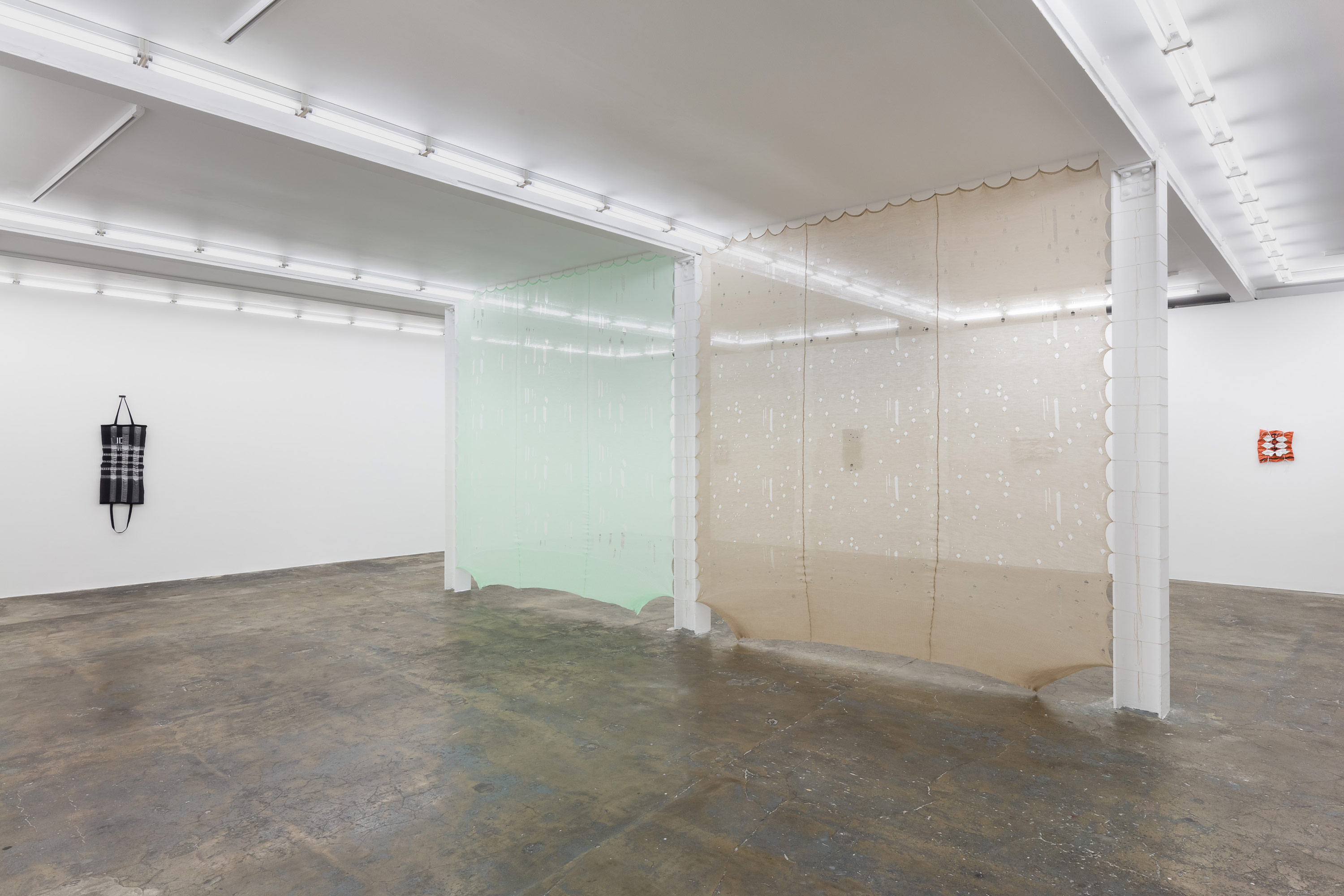In Ladder, Tenant of Culture presents a new body of work that examines the perceived dichotomy between destruction and decoration, interrogating how the aesthetic of waste has, for centuries, been appropriated within the fashion industry. These new wall-based and suspended works highlight the dissonance between the creation of physical waste and the aestheticization of damage.
In the exhibition, the artist expands her approach to undoing material, utilising traditional craft techniques based on the extraction or destruction of threads and fibres. These processes include devoré, open work embroidery and slicing as well as deconstructive methods developed through material experimentation to reference the practice in the garment industry of intentionally creating rips or slashes in previously undamaged clothing and accessories. The artificially ripped pair of jeans may be the most well-known contemporary example, but for centuries textile workers slashed garments as both a political act of resistance and a mechanism of control.
The cultural significance of the destruction of clothing is grounded in several notable moments in fashion’s industrial and stylistic history. The “cutters” movement of the mid 18th century utilised slashing as an act of protest, while the Spitalfields silk weavers engaged in campaigns of destroying each other’s work in a battle to stabilise wages. During the European Renaissance, the decorative technique of cutting slits in the outer layer of a garment to expose the fabric underneath was inspired by the distressed clothing of soldiers returning from battle, serving to visually distinguish political allegiances and social hierarchies. Today, the common approach of luxury brands is to slice unsold luxury goods to prevent value deflation; an economic strategy to create exclusivity through scarcity. Tenant of Culture explores this inheritance, disassembling and rebuilding manufactured garments to look at the politically charged treatment of textiles, examining the ways in which ideological frameworks with wide social implications materialise in methods of production, circulation and marketing of apparel.
Despite finding their genesis in acts of destruction, the works in Ladder incorporate features that reference decoration, either via symmetry, colour or adorning hardware. In the series Haul, Tenant of Culture slices and reconfigures garments stored in packaging materials using stitch. The sealed plastic bags suggest that destruction occurred prior to opening, while the repetitive method of slicing instead implies a carefully planned aesthetic act. Mimicking the ‘slashed sleeve’ decorative technique popular in the 16th century, the slashes are stitched open and decorated with ribbons and rivets that keep the damage in place, transforming the unpackaged item into a functionless object and eradicating its use value. Locating the works in contemporary shopping practices, the series Haul specifically refers to the online clothing market by incorporating the packaging of the industry’s most well-known e-tailers.
In the series Drawn, the artist artificially creates ladders and rips in deconstructed canvas tote bags, through a meticulous removal of warp and weft threads, followed by their reconfiguration via open work embroidery into a lace-like pattern. Drawn thread and cut-work are some of the earliest forms of embroidery and the technique was often used to re-create a cheaper version of the more costly handmade lace, utilising removal and undoing as a method to create a highly decorative and elaborate new textile. The tote bag symbolically represents another preoccupation of the contemporary shopping experience, where eco-conscious shoppers use the canvas bag as a sustainable alternative to single-use plastics. To tote, which means to lug or carry, again makes a reference to the transportation of goods.
In Sabotage in Acrylic (mint) and Sabotage in Acrylic (taupe), large panels of knitted fabric stretch between architectural features of the gallery. The word sabotage derives from the French word saboteur originally used to refer to labour disputes in which workers wearing wooden shoes called sabots interrupted production through different tactics, including the destruction of means of fabrication. These large-scale site-specific works simultaneously reference a renowned jumper designed by Rei Kawakubo for Comme des Garçons in the late 1980s, for which Kawakubo intentionally sabotaged knitting machines to create gaping holes. Made by a similar machine pre-programmed to introduce areas of faux damage, Tenant of Culture decorates the knitted panels with a pattern of various standardised holes and ladders. The Sabotage in Acrylic works therefore point at once to the historical tactic of sabotaging machinery as a way to negotiate labour conditions, as well as the process of the mass production and consumption of damage as a stylistic feature in the clothes we wear.
The works in Ladder examine the complex relation between fashion trends and their manufacturing processes. They aim to confront the cognitive dissonance between our individual relationship with clothes versus the global system in which they are produced by offering multiple perspectives – between individual desire and industry, transparency and concealment, the brand new and the discarded.
The exhibition will be accompanied by a text from Eilidh Duffy, available as part of a free, limited edition oversize pamphlet.

